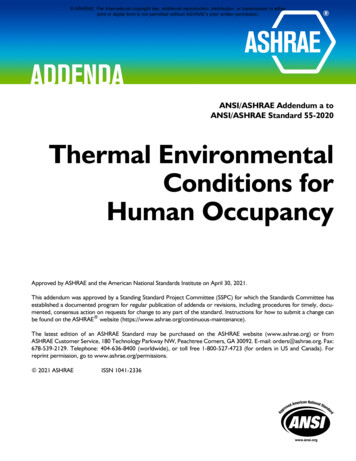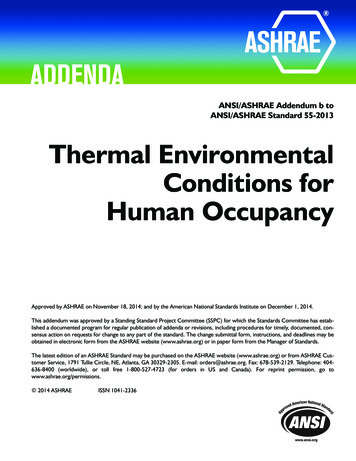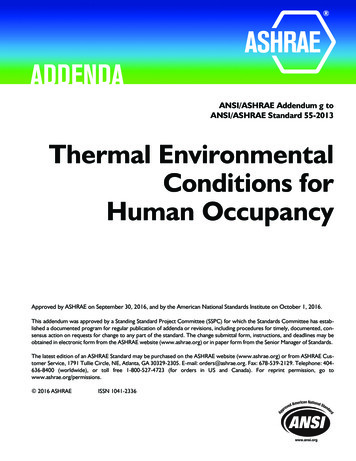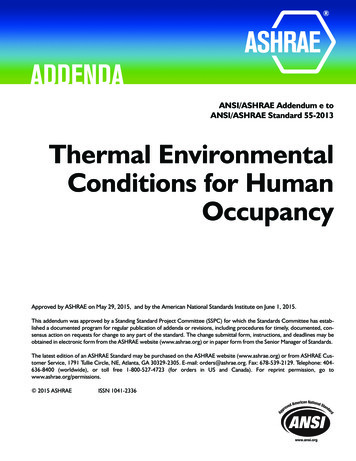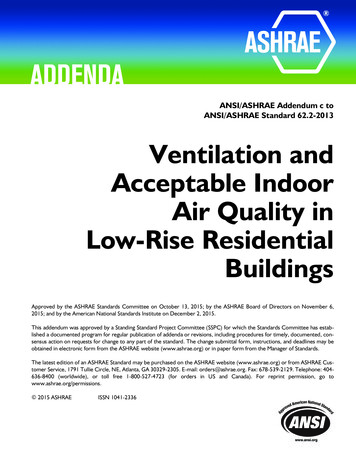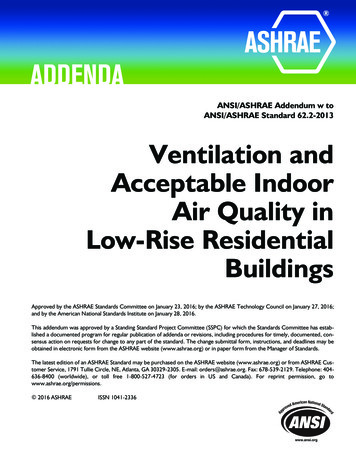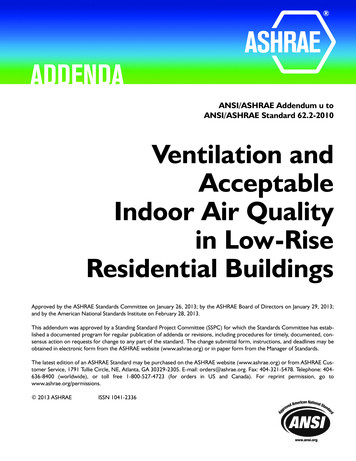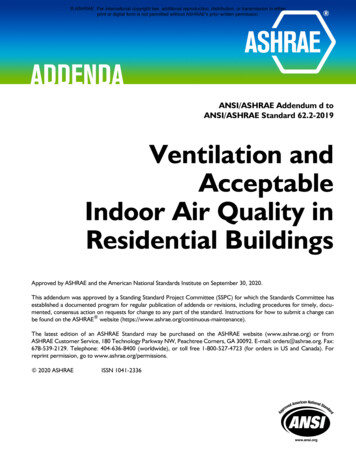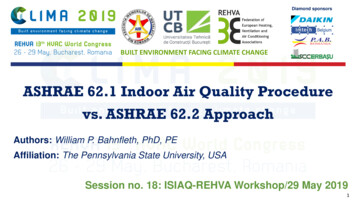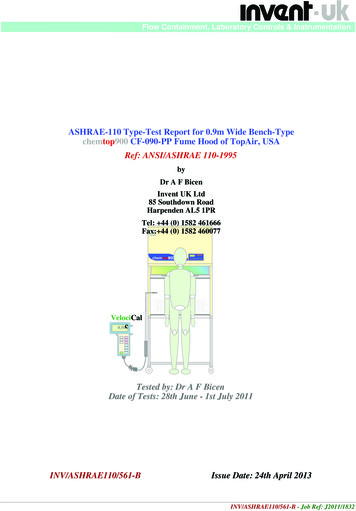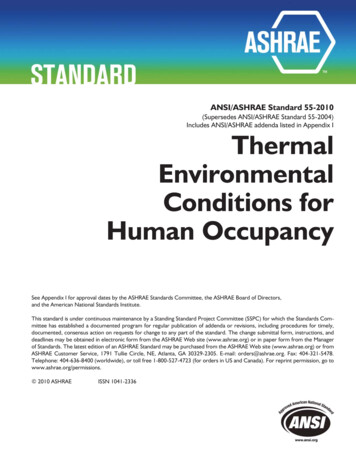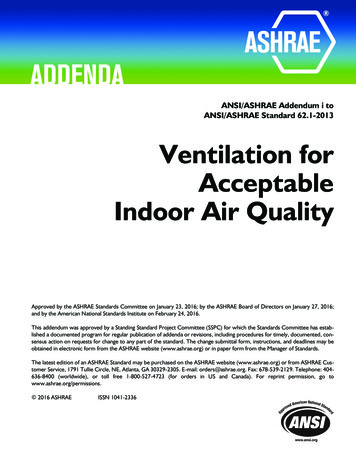
Transcription
ANSI/ASHRAE Addendum i toANSI/ASHRAE Standard 62.1-2013Ventilation forAcceptableIndoor Air QualityApproved by the ASHRAE Standards Committee on January 23, 2016; by the ASHRAE Board of Directors on January 27, 2016;and by the American National Standards Institute on February 24, 2016.This addendum was approved by a Standing Standard Project Committee (SSPC) for which the Standards Committee has established a documented program for regular publication of addenda or revisions, including procedures for timely, documented, consensus action on requests for change to any part of the standard. The change submittal form, instructions, and deadlines may beobtained in electronic form from the ASHRAE website (www.ashrae.org) or in paper form from the Manager of Standards.The latest edition of an ASHRAE Standard may be purchased on the ASHRAE website (www.ashrae.org) or from ASHRAE Customer Service, 1791 Tullie Circle, NE, Atlanta, GA 30329-2305. E-mail: orders@ashrae.org. Fax: 678-539-2129. Telephone: 404636-8400 (worldwide), or toll free 1-800-527-4723 (for orders in US and Canada). For reprint permission, go towww.ashrae.org/permissions. 2016 ASHRAEISSN 1041-2336
ASHRAE (www.ashrae.org). For personal use only. Additional reproduction, distribution,or transmission in either print or digital form is not permitted without ASHRAE's prior written permission.ASHRAE Standing Standard Project Committee 62.1Cognizant TC: 4.3, Ventilation Requirements and InfiltrationSPLS Liaison: John F. DunlapHoy R. Bohanon, Jr.*, ChairHamid Habibi*, Vice-ChairHugo O. Aguilar*Gary L. Berlin*Gregory BrunnerMark P. Buttner*Waller S. ClementsLeonard A. Damiano*Abdel K. Darwich*Paul L. DoppelHelen D. DavisFrancis J. Fisher, Jr.Gregg Gress*Brian J. Hafendorfer*Roger L. HedrickNathan L. HoElliott HornerEli P. Howard, IIIWayne E. MorrisKashif NawazJohn Nelson, Jr.Jonathan W.W. OlsenLaura G. Petrillo-Groh*Chandra Sekhar*Charles J. SeyfferJeffrey K. Smith*Wayne R. Thomann*W. Brad M. StanleyErica StewartPawel Wargocki*Josiah Wiley*Scott D. Williams*Marwa Zaatari* Denotes members of voting status when the document was approved for publicationASHRAE STANDARDS COMMITTEE 2015–2016Douglass T. Reindl, ChairRita M. Harrold, Vice-ChairJames D. AsweganNiels BidstrupDonald M. BrundageJohn A. ClarkWaller S. ClementsJohn F. DunlapJames W. Earley, Jr.Keith I. EmersonSteven J. EmmerichJulie M. FergusonWalter T. GrondzikRoger L. HedrickSrinivas KatipamulaRick A. LarsonLawrence C. MarkelArsen K. MelikovMark P. ModeraCyrus H. NasseriHeather L. PlattDavid RobinPeter SimmondsDennis A. StankeWayne H. Stoppelmoor, Jr.Jack H. ZarourJulia A. Keen, BOD ExOJames K. Vallort, COStephanie C. Reiniche, Senior Manager of StandardsSPECIAL NOTEThis American National Standard (ANS) is a national voluntary consensus Standard developed under the auspices of ASHRAE. Consensus is definedby the American National Standards Institute (ANSI), of which ASHRAE is a member and which has approved this Standard as an ANS, as“substantial agreement reached by directly and materially affected interest categories. This signifies the concurrence of more than a simplemajority, but not necessarily unanimity. Consensus requires that all views and objections be considered, and that an effort be made toward theirresolution.” Compliance with this Standard is voluntary until and unless a legal jurisdiction makes compliance mandatory through legislation.ASHRAE obtains consensus through participation of its national and international members, associated societies, and public review.ASHRAE Standards are prepared by a Project Committee appointed specifically for the purpose of writing the Standard. The Project CommitteeChair and Vice-Chair must be members of ASHRAE; while other committee members may or may not be ASHRAE members, all must be technicallyqualified in the subject area of the Standard. Every effort is made to balance the concerned interests on all Project Committees.The Senior Manager of Standards of ASHRAE should be contacted fora. interpretation of the contents of this Standard,b. participation in the next review of the Standard,c. offering constructive criticism for improving the Standard, ord. permission to reprint portions of the Standard.DISCLAIMERASHRAE uses its best efforts to promulgate Standards and Guidelines for the benefit of the public in light of available information and accepted industrypractices. However, ASHRAE does not guarantee, certify, or assure the safety or performance of any products, components, or systems tested, installed,or operated in accordance with ASHRAE’s Standards or Guidelines or that any tests conducted under its Standards or Guidelines will be nonhazardous orfree from risk.ASHRAE INDUSTRIAL ADVERTISING POLICY ON STANDARDSASHRAE Standards and Guidelines are established to assist industry and the public by offering a uniform method of testing for rating purposes, by suggestingsafe practices in designing and installing equipment, by providing proper definitions of this equipment, and by providing other information that may serveto guide the industry. The creation of ASHRAE Standards and Guidelines is determined by the need for them, and conformance to them is completelyvoluntary. In referring to this Standard or Guideline and in marking of equipment and in advertising, no claim shall be made, either stated or implied, thatthe product has been approved by ASHRAE.ASHRAE is a registered trademark of the American Society of Heating, Refrigerating and Air-Conditioning Engineers, Inc.ANSI is a registered trademark of the American National Standards Institute.
ASHRAE (www.ashrae.org). For personal use only. Additional reproduction, distribution,or transmission in either print or digital form is not permitted without ASHRAE's prior written permission.(This foreword is not part of this standard. It is merelyinformative and does not contain requirements necessaryfor conformance to the standard. It has not been processed according to the ANSI requirements for a standardand may contain material that has not been subject topublic review or a consensus process. Unresolved objectors on informative material are not offered the right toappeal at ASHRAE or ANSI.)tors on informative material are not offered the right toappeal at ASHRAE or ANSI.)FOREWORDThis appendix presents an alternative procedure for determining separation distance between outdoor air intakes andexhaust air and vent outlets. This analytical method can beused instead of Table 5.5.1.Exhaust air and vent outlets, as defined in Table 5.5.1,shall be located no closer to outdoor air intakes, and operablewindows, skylights, and doors, both those on the subjectproperty and those on adjacent properties, than the minimumseparation distance (L) specified in this section. The distance(L) is defined as the shortest “stretched string” distance measured from the closest point of the outlet opening to the closest point of the outdoor air intake opening or operablewindow, skylight, or door opening, along a trajectory as if astring were stretched between them.This addendum changes Appendix F, “Separation of ExhaustOutlets and Outdoor Air Intakes,” from informative to normative. This addendum is for the purpose of making language inthe standard mandatory in compliance with current ASHRAErequirements.Note: In this addendum, changes to the current standardare indicated in the text by underlining (for additions) andstrikethrough (for deletions) unless the instructions specifically mention some other means of indicating the changes.Addendum i to Standard 62.1-2013Add a new definition to Section 3 as shown.3. DEFINITIONSequipment well: an area (typically on the roof) enclosed onthree or four sides by walls that are less than 75% free area,and the lesser of the length and width of the enclosure is lessthan three times the average height of the walls. The free areaof the wall is the ratio of area of the openings through thewall, such as openings between louver blades and undercuts,divided by the gross area (length times height) of the wall.Modify Section 5.5.1 as shown.5.5 Outdoor Air Intakes. Ventilation system outdoorintakes shall be designed in accordance with the followingsubsections.5.5.1 Location. Outdoor air intakes (including openingsthat are required as part of a natural ventilation system) shallbe located such that the shortest distance from the intake toany specific potential outdoor contaminant source shall beequal to or greater than the separation distance (a) listed inTable 5.5.1 or (b) the calculation method in NormativeAppendix F.Exception: Other minimum separation distances shall bepermitted, provided it can be shown analytically that anequivalent or lesser rate of introduction of contaminants from outdoor sources will be attained.Note: Informative Appendix F presents an analyticalmethod for determining the minimum separation distancesbased on dilution of outdoor contaminants.Modify Informative Appendix F as shown.(This is a normative appendix and is part of the standard.)This appendix is not part of this standard. It is merelyinformative and does not contain requirements necessaryfor conformance to the standard. It has not been processed according to the ANSI requirements for a standardand may contain material that has not been subject topublic review or a consensus process. Unresolved objecANSI/ASHRAE Addendum i to ANSI/ASHRAE Standard 62.1-2013NORMATIVE INFORMATIVE APPENDIX FSEPARATION OF EXHAUST OUTLETS ANDOUTDOOR AIR INTAKESF1. GENERALF1.1 Application. Laboratory fume hood exhaust air outletsshall be in compliance with NFPA 455 and ANSI/AIHAZ9.56. Nonlaboratory eExhaust outlets and outdoor airintakes or other openings shall be separated in accordancewith the following.Exception: Laboratory fume hood exhaust air outlets shallbe in compliance with NFPA 45-2004 and ANSI/AIHAZ9.5-2003.F1.2 Outdoor Air Intakes. Minimum The minimum separation distance between exhaust air/vent outlets as defined inTable 5.5.1 and outdoor air intakes to mechanical ventilationsystems or operable windows, skylights, and doors that arerequired as part of natural ventilation systems shall be equalto distance (L) determined in accordance with Section F3 F2.Exception: Separation distances do not apply when exhaustand outdoor air intake systems do not are controlled suchthat they cannot operate simultaneously.F1.3 Other Building Openings. Minimum The minimumseparation distance between building exhaust air/vent outletsas defined in Table 5.5.1 and operable openings to occupiablespaces shall be half of the distance (L) determined in accordance with Section F3F2. Minimum The minimum separationdistance between high odor intensity or noxious or dangerouseither Class 3, Class 4, cooling tower, or combustion appliance/equipment exhaust air/vent outlets and operable openings to occupiable spaces shall be equal to the distance (L)determined in accordance with Section F3F2.F1.4 Additional Limitations for Noxious or DangerousAir. Minimum The minimum separation distance betweenexhausts located less than 65 ft (20 m) vertically below outdoor air intakes or operable windows and doors shall be equalto a horizontal separation only as determined in accordancewith Section F3 F2; no credit may be taken for any verticalseparation.F1.5 Equipment Wells. Exhaust air outlets that terminate inan equipment well that also encloses an outdoor air intakeshall meet the separation requirements of this section and, inaddition, shall either1
ASHRAE (www.ashrae.org). For personal use only. Additional reproduction, distribution,or transmission in either print or digital form is not permitted without ASHRAE's prior written permission.a. terminate at or above the highest enclosing wall and discharge air upward at a velocity exceeding 1000 fpm (5 m/s) orb. terminate 3 ft (1 m) above the highest enclosing wall (withno minimum velocity).Exception: Low contaminant or intensity air. Exhaust airdesignated as Class 1 or Class 2.For the purpose of this section, an equipment well is anarea (typically on the roof) enclosed on three or four sides bywalls that are less than 75% free area, and the lesser of thelength and width of the enclosure is less than three times theaverage height of the walls. The free area of the wall is theratio of area of the openings through the wall, such as openings between louver blades and undercuts, divided by thegross area (length times height) of the wall.F1.6 Property Lines. Minimum The minimum separationdistance between exhaust air/vent outlets and property linesshall be half of the distance (L) determined in accordancewith Section F3F2. For significant contaminant or odor intensity exhaust air, where the property line abuts a street or otherpublic way, no minimum separation is required if exhaust termination is 10 ft (3 m) above grade.Exception: For Class 3, Class 4, or combustion appliance/equipment exhaust air, where the property line abuts astreet or other public way, no minimum separation isrequired if exhaust termination is at least 10 ft (3 m)above grade.F2. DETERMINING DISTANCE LThe minimum separation Separation distance (L) shall bedetermined using any one of the following three approaches:a. A value Use the values of L in Table F2-1 shall be used.b. The value of Calculate L in accordance with shall bedetermined using Equation F2-1 or F2-2.L 0.09 · Q · ( DF – U/400) in feet(I-P)(F-1)L 0.04 · Q · ( DF – U/2) in meters(SI)(F-2)whereQU DF exhaust airflow rate volume, cfm (L/s). For gravityvents, such as plumbing vents, use an exhaust rate of150 cfm (75 L/s). For flue vents from fuel-burningappliances, assume a value of 250 cfm per millionBtu/h (0.43 L/s per kW) of combustion input (orobtain actual rates from the combustion appliancemanufacturer).exhaust air discharge velocity, fpm (m/s). As shownin Figure F2-1, U shall be determined using TableF2-3.dilution factor, which is the ratio of outdoor airflowto entrained exhaust airflow in the outdoor airin
ANSI/ASHRAE Standard 62.1-2013 Ventilation for Acceptable Indoor Air Quality Approved by the ASHRAE Standards Committee on January 23, 2016; by the ASHRAE Board of Directors on January 27, 2016; and by the American National Standards Institute on February 24, 2016. This addendum was approved by a Standing Standard Project Committee (SSPC) for which the Standards Committee has

